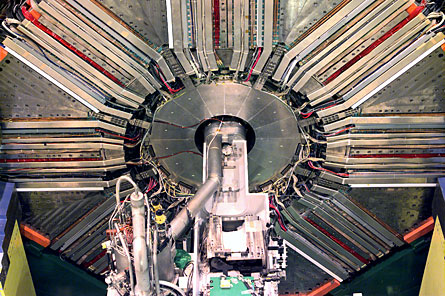In a weak moment, researchers have found an unexpected asymmetry in particle production that could hint at exotic physics. The tentative evidence, announced August 21, could be the fingerprint of a massive elementary particle that would help unify three of the four known forces in nature.

The physicists collected data for nearly a decade at the Belle particle accelerator experiment in Tsukuba, Japan. In the experiment, known as a B factory, beams of electrons and positrons collide to produce millions of pairs of B mesons and anti-B mesons. Such particles live brief but eventful lives, decaying through the weak nuclear force — the same force that powers some radioactivity and helps keep the sun burning.
In a mere 1.5 trillionths of a second, B mesons and their antiparticles disintegrate in any of hundreds of ways. In one of the more unusual decay paths — so rare it happens only about once in every million decays — a B meson turns into a particle called a K* meson and a particle-antiparticle pair. This pair can include an electron and its positively charged partner, the positron, or a heavier cousin to an electron, the muon, and its positively charged partner, the anti-muon.
The Belle team found that the number of positrons or anti-muons released in one direction, the direction of travel of the K* meson, doesn’t equal the number released in the opposite direction. The standard model of particle physics predicts such an asymmetry because the weak interaction picks a preferred direction in space. Physicists several decades ago traced this preference to massive messenger particles that mediate the interaction. As a result, the mirror image of a physical process involving the weak interaction doesn’t look the same as the original process.
However, the researchers found that the directional imbalance was slightly greater than the standard model predicts. That could mean that some additional type of massive elementary particle, briefly created during the decay process, has enhanced the asymmetry, says Belle collaborator Tom Browder of the University of Hawaii in Honolulu. The team presented the findings in Hamburg, Germany, at the International Symposium on Lepton-Photon Interactions at High Energies.
If an additional mystery particle were produced in the decay, it would have to be much heavier than the B meson that decayed in the first place. That seeming contradiction is permitted by the weird laws of quantum theory — as long as the heavy particle lasts for only a brief time. And such a particle could lend credence to the proposed theory of supersymmetry, which holds that every known elementary particle has a heavier partner. One of the proposed supersymmetric particles could be a candidate for dark matter, the elusive, invisible material that keeps galaxies intact.
“This is the strongest hint we’ve had so far” of physics beyond the standard model, Browder says.
But with only about 230 of the rare B meson decays generated at Belle so far, the team can’t yet reach a firm conclusion, Browder says. Physicist Andreas Kronfeld of the Fermi National Accelerator Laboratory in Batavia, Ill., agrees that the finding is intriguing but tentative.
A proposed upgrade of the Japanese facility would feature a more sensitive detector and more intense beams that could produce about 100 times as many B mesons, Browder notes. The three-year renovation, which would require the current B factory to shut down, could begin next year.
The much more powerful Large Hadron Collider accelerator near Geneva, once it’s finally operating at full capacity, could look directly for tracks left by the proposed particle, Kronfeld says.







